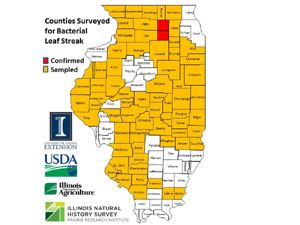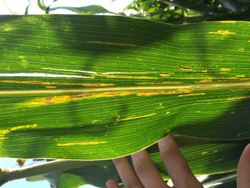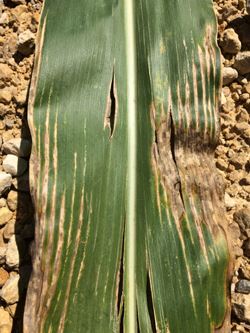|
New Bacterial Leaf Disease “Bacterial Leaf Streak” Identified In One Northern Illinois County
Extension Staff Join With Other Agencies To Survey
Illinois For New Corn Disease 2016
DR. N. DENNIS BOWMAN AND DR. SUZANNE BISSONNETTE
URBANA, ILL.
The USDA just announced the presence of Bacterial leaf streak in corn, as determined by recent surveys of the Corn Belt states. In Illinois, a cooperative survey was organized with APHIS-PPQ (Animal Plant Health Inspection Service), IDA (Illinois Department of Agriculture), CAPS (Illinois Natural History Survey’s Cooperative Agricultural Pest Survey) and University of Illinois Extension to provide a rapid response to determine distribution.
In a short time window, our surveyors examined randomly selected fields in transects across 68 of Illinois’s 102 counties. They looked for Bacterial leaf streak symptoms in approximately 340 fields across the state. Leaves with suspicious symptoms were collected and have been sent to a USDA laboratory for evaluation. The Extension surveyors consisted of volunteers from the Commercial Agriculture, Small Farms and Local Foods and the Energy and Environment teams.
One positive sample of Bacterial leaf streak was found in DeKalb County, IL and identification was verified by the USDA yesterday. This is the only county in Illinois that has been verified to have the disease. So far, Bacterial leaf streak has been identified in 9 states: Colorado, Iowa, Illinois, Kansas, Minnesota, Nebraska, Oklahoma, South Dakota, and Texas, figure 1.
Bacterial leaf streak is caused by the pathogen Xanthomonas vasicola pv. vasculorum. The disease causes the formation of linear lesions between the veins on a corn leaf. The lesions look similar to gray leaf spot (GLS) symptoms. GLS lesions tend to be shorter, more rectangular and stay within their veinal borders. Bacterial leaf streak lesions are more irregular, often thinner and longer, will “bleed” over the veinal border and may have a halo when held up to the light.
In many Great Plains states that have found the disease, symptoms first appear on the lower leaves and infection progresses up the plant. Typically these fields have been under pivot irrigation. However later infections may occur and show up primarily in the upper canopy, as was the case for the positive DeKalb county sample. There is currently very little known about this disease. Further research is needed to develop a complete understanding of this disease, its impact and strategies for long term management. However, APHIS notes it is not believed to present a health risk to people or animals.
Since this is a bacterial disease, fungicides cannot be expected to control or suppress this disease. Crop rotation and tillage are the best short-term management strategies if the disease is present in a field. Differences in varietal susceptibility may point the way to sources of resistance.
If you suspect Bacterial leaf streak, submit a sample to the University of Illinois Plant Clinic http://web.extension.illinois.edu/plantclinic/ We would like to get a comprehensive idea of distribution in the state. For more information on Bacterial leaf streak, biology, symptoms, or management, please visit: http://cropwatch.unl.edu/bacterial-leaf-streak from University of Illinois alumna Dr.Tamra Jackson-Ziems, Nebraska Extension Plant Pathologist, and http://broderslab.agsci.colostate.edu/corn-bacterial-leaf-streak/. ∆
DR. N. DENNIS BOWMAN: Extension Educator, Commercial Agriculture, University of Illinois
DR. SUZANNE BISSONNETTE: Assistant Dean, Agriculture and Natural Resources, University of Illinois

Figure 1. Illinois surveyed counties for Bacterial leaf streak 2016.

Foliar symptoms of Bacterial leaf streak showing long lesions with wavy margins
and halo visible with back-lighting.
Photo courtesy of Scott Schirmer Illinois Department of Agriculture, State Plant Regulatory Official.

Picture 2: Late foliar symptoms of Bacterial leaf streak showing long lesions.
Photo courtesy of Scott Schirmer Illinois Department of Agriculture, State Plant Regulatory Official.
|
|